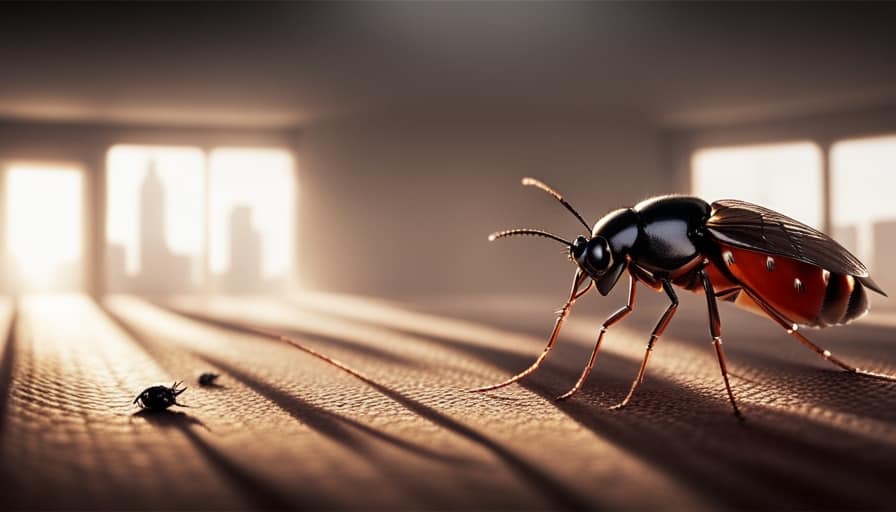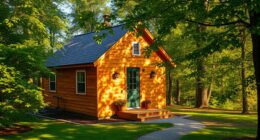I’m here to offer some advice on how I prevent the water pipes from freezing in my small house. It can be a struggle, but using the correct methods, it is achievable to avoid this problem.
Insulation, heating options, proper ventilation, and winterizing are all key factors to consider. By implementing these strategies, you can ensure your pipes stay warm and functional even in the coldest of winters.
So, let’s dive in and learn how to protect those pipes!
Key Takeaways
- Proper insulation techniques, such as using foam or fiberglass insulation and creating a barrier around the pipes, can help prevent water pipes from freezing in a tiny house.
- Heating options like space heaters or a central heating system can be used to keep pipes warm and prevent freezing.
- Proper ventilation and air circulation, through the use of exhaust fans, passive ventilation, and sealing drafts, can also help protect pipes from freezing.
- Winterizing the tiny house with pipe insulation, heat tape, thermostat settings, and other measures can minimize the risk of frozen pipes, prevent costly repairs, and maintain water flow and quality.
Understanding the Risks of Frozen Water Pipes in a Tiny House
I need to understand the risks of frozen water pipes in my tiny house.

In order to serve others effectively, it’s important to be knowledgeable about the common causes of frozen water pipes in tiny houses. One common cause is when the temperature drops below freezing outside, especially if the house isn’t properly insulated. Another cause can be inadequate insulation around the pipes themselves, allowing cold air to reach them.
It’s crucial to be able to identify the signs of frozen water pipes in a tiny house, such as little or no water coming out of the faucets, strange noises in the pipes, or visible frost on the pipes. If you do encounter frozen water pipes, it’s essential to thaw them safely using techniques like using a hairdryer or wrapping them with warm towels.
Understanding these risks and knowing how to address them will help prevent damage and ensure a properly functioning water system in a tiny house.
As we move forward, let’s explore insulation techniques to prevent water pipes from freezing.

Insulation Techniques to Prevent Water Pipes From Freezing
To effectively prevent water pipes from freezing in a tiny house, it’s important to use sufficient insulation techniques.
Passive insulation is a highly effective method to keep water pipes from freezing. This type of insulation involves creating a barrier around the pipes using materials with high insulating properties, such as foam or fiberglass insulation. This helps to keep the heat inside the pipes and prevent it from escaping, thereby maintaining a warm temperature and preventing freezing.
Another effective technique is the use of heat tape. Heat tape is an electrical device that wraps around the pipes and provides a constant source of heat, preventing freezing even in extremely cold temperatures. It’s important to install heat tape correctly and ensure it’s working properly to guarantee its effectiveness.
Heating Options for Tiny Houses to Keep Pipes Warm
One heating option for tiny houses to keep pipes warm is using a space heater. Space heaters are portable and can provide localized heating to specific areas of the house. When using a space heater for pipe protection, it’s important to place it near the vulnerable pipes, ensuring that the heat is directed towards them. Additionally, it’s crucial to keep the space heater away from any flammable materials to prevent accidents.
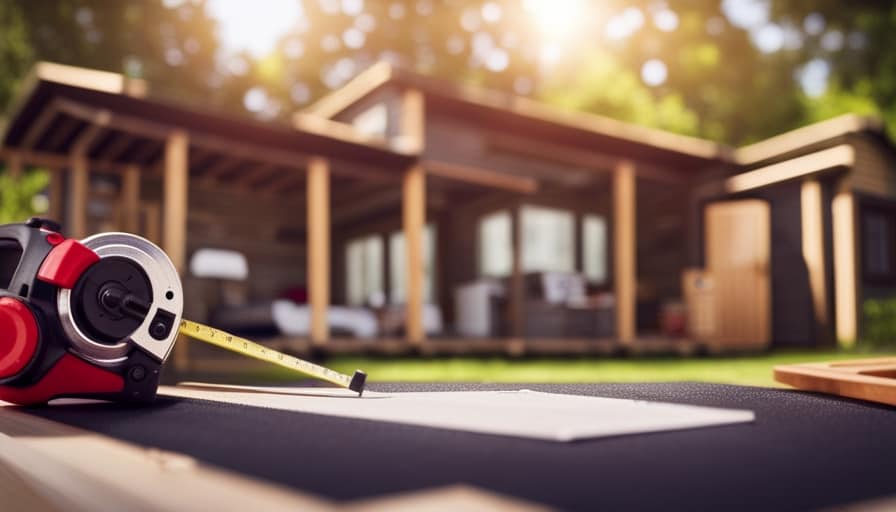
Another heating option is to install a central heating system in the tiny house. This system can provide consistent heat throughout the entire space, ensuring that all pipes are kept warm. However, it’s important to insulate the pipes properly to maximize the efficiency of the heating system and prevent heat loss. By insulating the pipes, the heat will be retained, reducing the risk of freezing.
Transitioning into the next section, proper ventilation and air circulation are also essential factors in protecting the pipes from freezing.
Proper Ventilation and Air Circulation for Pipe Protection
Having sufficient airflow is crucial for preventing water pipes from freezing in a tiny house. Proper ventilation techniques and air circulation play a significant role in pipe protection. Here are three ways to ensure adequate ventilation and moisture control in your tiny house:
-
Install an exhaust fan: By placing an exhaust fan in your bathroom and kitchen, you can effectively remove excess moisture from the air. This helps prevent condensation buildup and reduces the risk of freezing pipes.
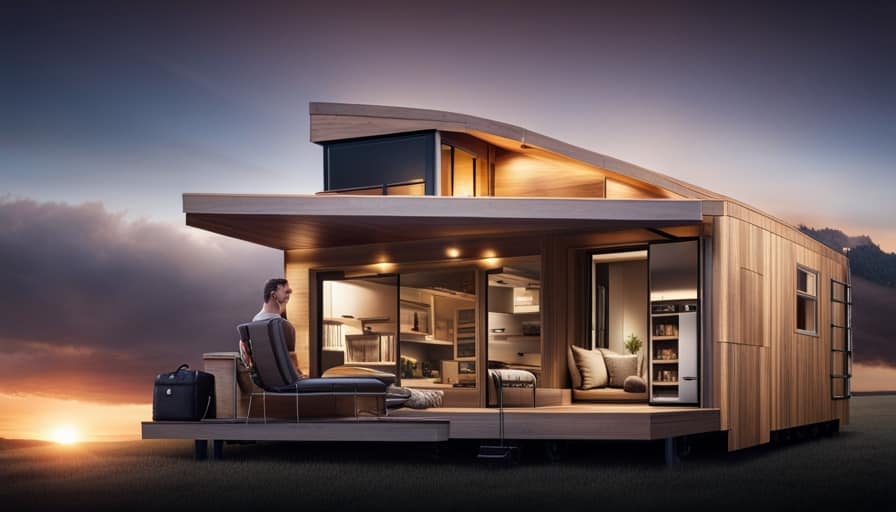
-
Use passive ventilation: Incorporate vents or louvers in strategic locations to allow fresh air to circulate throughout your tiny house. This helps maintain a consistent temperature and prevents the accumulation of stagnant air.
-
Insulate and seal your tiny house: Proper insulation and sealing techniques can prevent drafts and cold air infiltration. This helps maintain a stable indoor temperature and reduces the chances of freezing pipes.
Winterizing Your Tiny House: Additional Tips for Frozen Pipe Prevention
And, as an experienced tiny house owner, I’ve found that there are additional tips for preventing frozen pipes during the winterization process. In addition to proper ventilation and air circulation, pipe insulation and heat tape installation are crucial steps in keeping your water pipes from freezing in a tiny house.
Pipe insulation is a cost-effective solution that provides a protective barrier around your pipes, preventing heat loss and freezing. It is available in various materials such as foam, rubber, and fiberglass, and can be easily installed by wrapping it around the pipes.
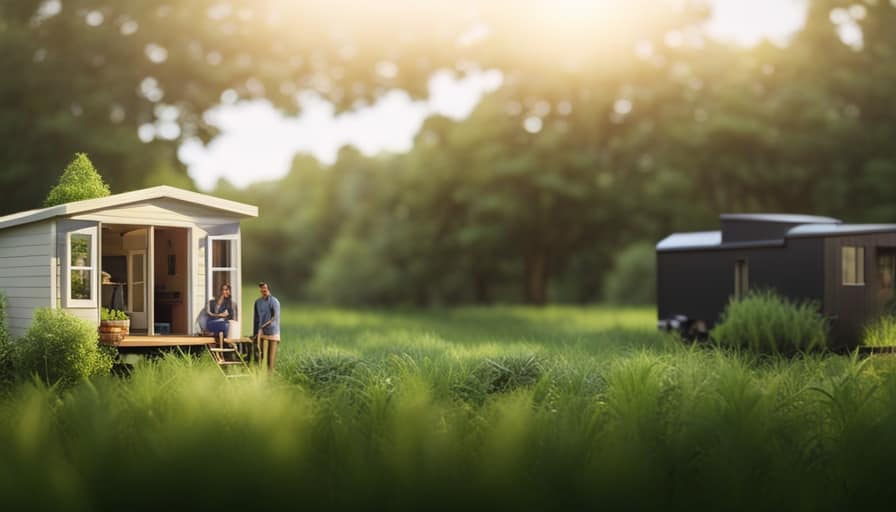
Heat tape installation is another effective method for preventing frozen pipes. Heat tape is an electrical heating element that can be wrapped around the pipes. It provides a constant source of heat, ensuring that the pipes remain above freezing temperatures.
By incorporating these additional tips of pipe insulation and heat tape installation, you can further winterize your tiny house and minimize the risk of frozen pipes.
| Pipe Insulation | Heat Tape Installation |
|---|---|
| Provides insulation | Provides constant heat |
| Prevents heat loss | Prevents freezing |
| Easy to install | Wraps around pipes |
Frequently Asked Questions
What Is the Cost of Insulating Water Pipes in a Tiny House?
Insulating water pipes in a tiny house can vary in cost depending on the type of insulation used. Eco-friendly insulation options such as foam and pipe wraps are available, providing effective protection against freezing while being mindful of the environment.
Can I Use Heat Tape to Prevent Water Pipes From Freezing?
Yes, I can use heat tape to prevent water pipes from freezing in my tiny house. However, it’s important to also consider using foam insulation or exploring alternative insulation options to ensure maximum protection.

How Often Should I Check My Water Pipes for Signs of Freezing?
I regularly check my water pipes for signs of freezing to prevent any potential damage. It’s important to be proactive and check them at least once a week during colder months to catch any issues early on.
Are There Any Eco-Friendly Insulation Options for Tiny House Water Pipes?
There are eco-friendly insulation options available for water pipes in a tiny house. Sustainable alternatives, such as foam pipe insulation made from recycled materials, can help prevent freezing and reduce energy consumption.
Can I Use a Space Heater as a Heating Option for My Tiny House Water Pipes?
I don’t recommend using a space heater as a heating option for tiny house water pipes due to safety concerns. However, there are alternative heating options available that can effectively prevent freezing, such as heat tape or insulated pipe sleeves.
Conclusion
In conclusion, frozen water pipes can pose a significant risk in tiny houses, but with proper insulation, heating options, and ventilation, you can prevent this issue.
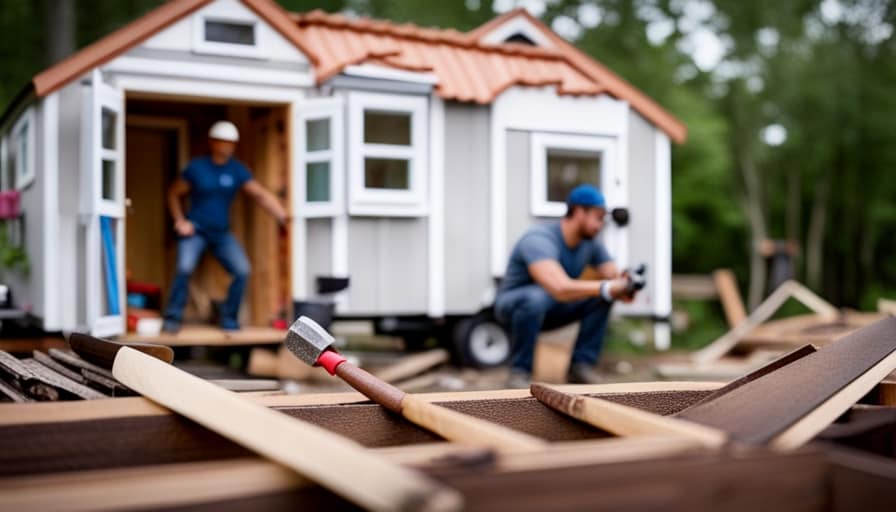
Interestingly, did you know that even a small crack in a water pipe can cause up to 250 gallons of water to leak per day? This statistic highlights the importance of taking preventative measures to protect your pipes and avoid potential water damage in your tiny house.
Stay warm and keep those pipes flowing!
I’m Theodore, and I love tiny houses. In fact, I’m the author of Tiny House 43, a book about tiny houses that are also tree houses. I think they’re magical places where imaginations can run wild and adventures are just waiting to happen.
While tree houses are often associated with childhood, they can be the perfect adult retreat. They offer a cozy space to relax and unwind, surrounded by nature. And since they’re typically built on stilts or raised platforms, they offer stunning views that traditional homes simply can’t match.
If you’re looking for a unique and romantic getaway, a tree house tiny house might just be the perfect option.

